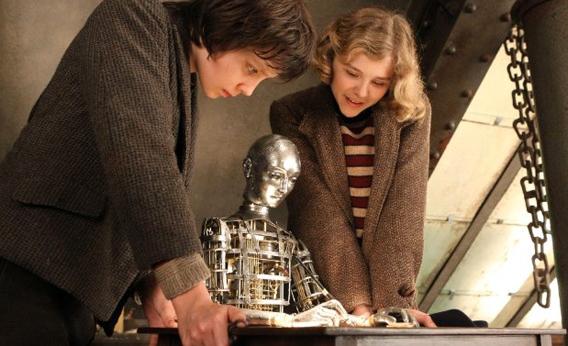Hugo, Martin Scorsese’s adaptation of the best-selling children’s novel The Invention of Hugo Cabret by Brian Selznick, is an exquisitely crafted, high-tech period piece with the sleek finish of a faux-vintage Christmas ornament. At the same time, Hugo is a deeply personal film for its 69-year-old director, who comes as close as he ever has to creating a Fanny and Alexander-style autobiographical fiction. If you want to know what little Marty was like, you may never get a better glimpse than in Hugo (with Paris of the ’30s standing in for Little Italy of the ’50s, and a homeless orphan for the housebound asthmatic kid Scorsese was). Yet somehow, for me, this earnest, pretty movie never came to life on screen; it remained a curio in a cabinet, to be admired through a pane of glass.
To be certain, this is a movie about watching, both in the sense of watching movies and of observing other people’s lives. The huge blue eyes doing all this watching belong to a 12-year-old boy, Hugo Cabret (Asa Butterfield) who lives at the Gare Montparnasse railway station, where he meets and eventually befriends Georges Méliès, the turn-of-the-century filmmaker who’s known as the father of modern special effects.
Hugo could use a father of any sort. His own, a clockmaker (played in a one-scene flashback by Jude Law), recently died in a fire, leaving the child an orphan (his mother having perished long ago). The boy is taken in by his uncle Claude (Ray Winstone), a mean drunk, to live in a dingy room behind the station clocks, where he’s trained to wind the gears of the giant timepieces each day. After his uncle mysteriously disappears, Hugo must shift for himself, surviving on croissants and milk he swipes from the station café.
Hugo also pilfers small objects from the booth of an old toy salesman in the station, a bitter man known only as Papa Georges (Ben Kingsley). When Hugo is caught red-handed one day, the old man confiscates a notebook left to the boy by his father. Desperate to retrieve it, Hugo pleads his case to the old man’s bookish granddaughter, Isabelle (Chloë Grace Moretz), who manages to get the notebook back to him. In return, Hugo shows her his most precious possession: an old automaton that he and his father were working together to restore.
With the help of a film scholar they meet in the library, René Tabard (Michael Stuhlbarg), the children eventually discover what this broken-down mechanical man has to do with Papa Georges, who, it turns out, is none other than Georges Méliès, the great cinematic innovator whose films are in danger of being lost to time and neglect. In these scenes, Hugo threatens to lose its child audience: It’s hard to imagine most kids getting goose bumps when Tabard slowly opens a drawer to reveal … a dusty film canister. But the sequences in which Sacha Baron Cohen, as a buffoonish station inspector, chases Hugo through the building with a Doberman (and Scorsese’s nimble camera) in hot pursuit make for agreeably broad comedy in the Blake Edwards mode. (Could Borat have a future as our next Peter Sellers?)
A lyrical and visually sumptuous late flashback shows us Méliès’ memories of his early days as a filmmaker, when he would dress up his wife and friends as mermaids, gods, and lobsters in order to “film his dreams” in an all-glass movie studio. These images are filled with light, energy, and movement (and the scraps of real, hand-tinted Méliès films we get to see are wildly inventive and beautiful). It’s a downer when the old man’s reverie ends and we re-enter the locked-down aesthetic universe of this movie’s present day.
After the luminous transparency of the city as seen in Woody Allen’s Midnight in Paris, Scorsese’s storybook version of Paris (recreated, for most of the film, on a soundstage at England’s Shepperton Studios) feels art-directed to within an inch of its life. There’s much to marvel at inside this pristine snow globe—especially any scene involving the automaton, a graceful, enigmatic creation that’s more expressive than some of the living performers onscreen. But despite Scorsese’s constantly roving 3-D camera (it zips around corners, drops down stairwells, and in a thrilling opening shot, races through a crowd of passengers on a platform between two trains), Hugo often feels static and airless.
Asa Butterfield has a lovely fragility as the lonely Hugo, though the role doesn’t give him a lot to do other than gaze saucer-eyed out at the world. But Chloë Grace Moretz (who played the foul-mouthed Hit Girl in the superhero fantasy Kick-Ass) has always felt like an overly self-conscious child actress to me; as my viewing companion astutely put it, she seems to be secretly exulting, “I’m in a movie!” Kingsley and Helen McCrory bring a quiet grace to their roles as the aged Monsieur and Madame Méliès and prove in the flashback scenes that (are you reading, Clint Eastwood?) it’s easier to age good actors downward than upward.
This visually and sonically lush picture is never less than a pleasure to the eye and ear (even if Howard Shore’s symphonic score is a little too omnipresent). The in-camera 3-D effects look fantastic, and the production design by the legendary Dante Ferretti is richly imaginative. With all that going for it, maybe it doesn’t matter that Hugo is one part PSA for Scorsese’s film-preservation efforts, one part children’s adventure story, and one part meditation on artistic legacy: the story of a filmmaker who was nearly forgotten by history, told by a filmmaker who wants to make sure he won’t be.
